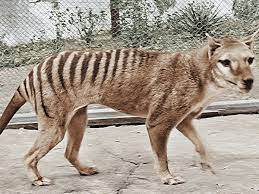Melbourne, Aug 17: Researchers in Australia and the US are embarking on a multi-million dollar project to bring the Tasmanian tiger back from extinction, the media reported.
The last known one, officially called a thylacine, died in the 1930s. The team behind the bid say it can be recreated using stem cells and gene-editing technology, and the first thylacine could be reintroduced to the wild in 10 years’ time, the BBC report said.
Other experts are sceptical and suggest de-extinction is just science fiction. The thylacine earned its nickname of Tasmanian tiger for the stripes along its back — but it was actually a marsupial, the type of Australian mammal that raises its young in a pouch.
The group of Australian and US scientists plan to take stem cells from a living marsupial species with similar DNA, and then use gene-editing technology to “bring back” the extinct species — or an extremely close approximation of it.
It would represent a remarkable achievement for the researchers attempting it, and require a number of scientific breakthroughs. “I now believe that in 10 years’ time we could have our first living baby thylacine since they were hunted to extinction close to a century ago,” the BBC quoted Professor Andrew Pask, who is leading the research from the University of Melbourne, as saying.
The population of Tasmanian tigers declined when humans arrived in Australia tens of thousands of years ago, and again when dingoes — a species of wild dog — appeared.
Eventually, the marsupial only roamed free on the island of Tasmania, and was ultimately hunted to extinction. The last captive Tasmanian tiger died at Hobart Zoo in 1936.
If scientists were to succeed in reviving the animal it would mark the first “de-extinction” event in history, but many outside experts are doubtful of the science behind it.
“De-extinction is a fairy tale science,” Associate Professor Jeremy Austin from the Australian Centre for Ancient DNA told the Sydney Morning Herald, adding that the project was “more about media attention for the scientists and less about doing serious science”. The idea of bringing back the Tasmanian tiger has been around for more than 20 years. (UNI)
Trending Now
E-Paper


